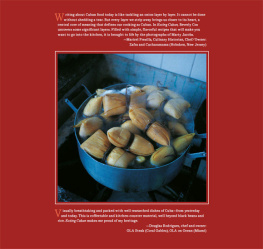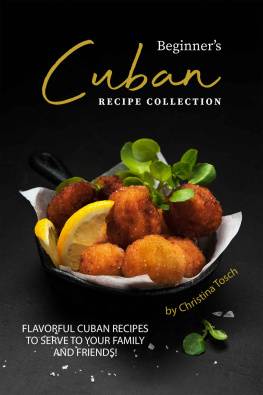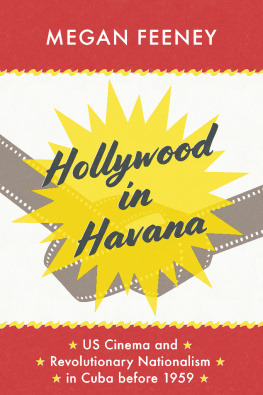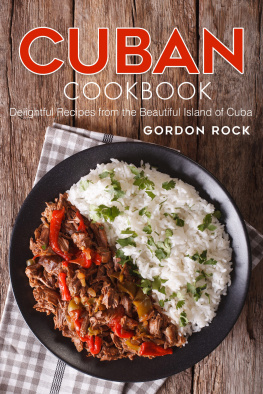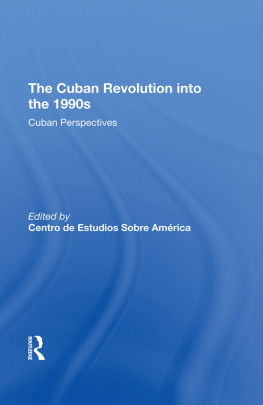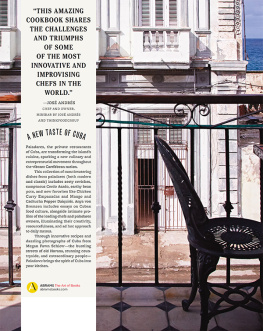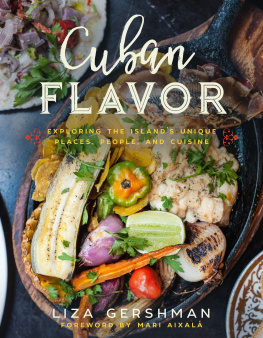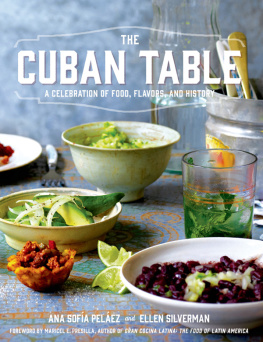



To Craig Jacobs, whose love of all things Cuban inspired us.
Editor: Marisa Bulzone
Designer: Laura Lindgren
Production Manager: Jane Searle
Library of Congress Cataloging-in-Publication Data
Cox, Beverly
Eating Cuban : 120 authentic recipes from the streets of Havana to American shores / Beverly Cox and Martin Jacobs ; Introduction by Ana Menndez.
p. cm.
Includes bibliographical references and index.
ISBN 1-58479-541-7
eISBN: 978-1-68335-182-5
1. Cookery, Cuban. I. Jacobs, Martin. II. Title.
TX716.C8C69 2006
641.597291dc22 2006008795
Text copyright 2006 by Beverly Cox
Photographs copyright 2006 by Martin Jacobs
Published in 2006 by Stewart, Tabori & Chang
An imprint of Harry N. Abrams, Inc.
All rights reserved. No portion of this book may be reproduced, stored in a retrieval system, or transmitted in any form or by any means, mechanical, electronic, photocopying, recording, or otherwise, without written permission from the publisher.

ABRAMS The Arts of Books
115 West 18th Street, New York, NY 10011
abramsbooks.com
Preface
My grandmothers, May Cox and Elizabeth Walker, loved to travel. They were both widows and, though quite different in personality, compatible travel companions. Every year after the Christmas holidays, they embarked on a train journey around the United States that impressed me, as a small child, because the excursion tickets were so long that they stretched across the room. A high point of the trip was a cruise from Miami to Havana, where they would spend a few days touring the island. Cuba, as they described it to the family in vivid detail, was a tropical paradise with great food and hospitable people who showed special kindness to senior citizens and children. I remember plotting to convince my parents that visiting Cuba with the Grandmas would be much more educational than school, but my dream trip never materialized.
In the 1950s, when Havana was a popular tourist destination, no one would have believed that an island ninety miles off the coast of Florida would soon become less accessible to Americans than Tibet or Timbuktu. And yet, part of Cubas special appeal today is just that:, it has been off limits for so long. Naturally then, I was intrigued when Marty Jacobs told me that his son Craig, who is a chef, had been traveling to Havana on business. When he brought up the possibility that we could legally accompany Craig as food consultants and explore the cooking of modern Cuba, I started mentally packing my suitcase.

Cuba has a rich culinary history that reflects the influences of Native American, Spanish, African, Chinese, and French immigrations. From what we have found on our trips to Havana, the food at most tourist hotels is not great, but good Cuban cooking can still be found at paladares (private restaurants), some of which are very elegant and others just simple take-out windows in peoples homes. People in the countryside also eat well because they grow a lot of their own food. Since meat, particularly beef, is still hard to come by in the cities, there are also some interesting vegetarian restaurants where the chefs cook with local produce.
Over the past fifty years, wherever Cubans have settled in the United States, their food has had an impact. This is especially true in Florida cities like Tampa and Miami, where it is very popular. Among the dishes that have become American favorites are Cuban black bean soup, tostones (double deep-fried green plaintain chips), empanadas (pastry turnovers filled with spicy beef filling), sandwich Cubano (a toasted submarine sandwich), ropa vieja (shredded beef in tomato sauce), Moros y Cristianos (black beans and rice), and flan (Cuban caramel custard).
On our travels to Cuba we have been very fortunate to meet many kind and hospitable people. Some great Cuban cooks, both professional and amateur, have generously shared their knowledge and recipes with us. In spite of frequent difficulties in obtaining ingredients, creative cooks seem able to prevail. And we hope that the photographs will help readers appreciate the flavor and beauty of the island.

Marty and I would like to thank our friends in Cuba: Rafael and his wonderful family, Justo and Rosario. David, Lucy, Isabel and Frank, Eduardo, Alicia and Ellie, Alejandro and Amarilis, Hubert and Manolo, Raquel, Madelaine, Maria Elena, Carmen and Enrique, Beatriz and Jaime, Susana and the two Jorges, Marta, Juan Carlos and Lidia Olga.
And we have met many great Cuban-American cooks, particularly in Miami, Tampa and Gulfport, Florida, and Hoboken, New Jersey, who have shared their recipes and knowledge of the exciting Cuban food scene in the United States. Many thanks to Juanita Plana, Lucila Venet Jimenez, Virginia Flores-Godoy and Gustavo Godoy, Maricel Presilla, Josefa Gonzales-Hastings, Douglas Rodriguez, Jorge and Tamara Salt, Sixto Delgado, Dan Cuado, Luis and Juanita Tejada, and Majito Aguila.
Writing and publishing a cookbook requires the efforts of many people. This project would not have been possible without the help of Craig and Michelle Jacobs. We would like to thank our spouses, Linda Johnson, who, as always, did a wonderful job of styling the photographs, and Gordon Black, who typed and organized the manuscript. My friend, and the worlds best test cook, Judy Day was a joy to work with. This project also brought to my attention another great Cuban-American cook, Barbara Trujillo, who tested the recipes in the drinks chapter and acted as an on-site Cuban consultant for the book. My mother, Betty Cox, and the Day and Trujillo families were excellent tasters, and we appreciated their input.

Ana Menndez, eloquent as always, wrote a wonderful introduction. Our agent Judith Weber, and publisher Leslie Stoker and editor Marisa Bulzone at Stewart, Tabori and Chang, have encouraged and supported us from the beginning and shared our excitement about the rare opportunity we had to visit Cuba. Many thanks also to copy editor Liana Krissoff, who converted recipes and text into a polished manuscript and to designer Laura Lindgren, who wove all of the visual and editorial elements into a finished book that pleased us all.
Our travelsand the creation of this bookhave been a great culinary adventure and we are eager to share it with you.
Buen Provecho!
Beverly Cox and Martin Jacobs
Introduction
by Ana Menndez
My favorite Cuban delicacy isnt really the stuff of fine cookbooks. It was born not in a test kitchen but in that creative cauldron called the screw-up. Raspita is the crunchy toasted rice at the bottom of a pot thats been left too long on the heat. After you scrape it up, raspitas nutty crackle becomes the perfect foil to a bowl of soft steaming rice. Delicious and forgiving, raspita is a fine reminder that there is joy even in error and that sometimes an excess of competence can yield its own kind of hunger.
Next page
